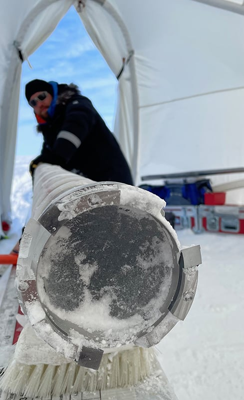Polar ice reveals how lead diminished the intelligence of the Romans.
Modern humanity is well aware of the harmful effects of lead: in the 1920s, American chemist Thomas Midgley introduced tetraethyl lead as an additive to gasoline. Knowing that this substance was dangerous, he managed to convince the public by publicly swallowing it in front of photographers, after which he secretly left for long-term medical treatment. As a result of his actions, by the mid-20th century, lead became globally prevalent in the air. The IQ of children dropped several points below what it should have been, and their aggression significantly and permanently increased. This process affected billions of people, and the attempts of honest scientists to halt the use of tetraethyl lead led to their "removal" from the academic community. After a couple of decades, they eventually triumphed; tetraethyl lead was banned, leading to a sharp decline in crime rates in developed countries.
Naturally, historians began to vigorously discuss whether lead could have significantly influenced the development of earlier civilizations. The Romans used lead in coating dishes, as a preservative for wine, as a material for plumbing, in making projectiles for slings, and much more. However, it is impossible to measure how high the levels of water and air pollution were in their era. The lead content in skeletons is also not very informative.

Furthermore, some historians suggested that if the Roman elite had high levels of lead in their bodies (Roman women used lead-based cosmetics, and aristocrats drank diluted wine alongside water), the majority of the population could not afford cosmetics or wine. Lead pipes, typical in Rome, quickly become coated with calcified deposits when exposed to hard water, blocking lead and reducing its levels in the water. Similar precedents are well-known in modern-day USA, where lead pipes have yet to be completely replaced.
Now, researchers from the American Desert Research Institute sought to determine the level of pollution not in water and food, but in the air during Roman times. To accomplish this, they collected ice samples obtained from drilling in the ice of Antarctica and Greenland, dated to the period of the Roman Republic and Empire. An article on this topic was published in PNAS.

Lead has different isotopic ratios depending on its deposits. Therefore, the authors of the study were able to reliably correlate the sharp increase in lead levels in air bubbles trapped within the ice with European sources. In the ancient world, lead content in the air peaked first in the 2nd century BC — during the height of the Roman Republic. Then, in the 1st century BC, lead levels in the air sharply declined: the crisis of the Republic and civil wars seemingly reduced the ability to conduct normal economic activities, and mining of lead-containing ores decreased. From 15 BC to 165-185 AD, the level rose again to a peak. During this time, more than half a million tons of lead entered the atmosphere through the mining sector of the Roman Empire.
The timeline here is quite explicable: by 15 BC, Emperor Augustus had stabilized economic life after the turbulence of the late Republic. The decline after 165 AD is also understandable: that was when the plague ("Antonine Plague") swept through the empire, killing tens of percent of its population. Apparently, from that point on, the population of the Roman state never again reached the peak levels of the first two centuries AD. A smaller population inevitably meant less metallurgy.

The levels of lead during the Roman peak are low compared to the 20th century, when air lead content was sometimes 40 times higher. However, in comparison with the rest of human history, these figures are significant. For example, in Europe, such levels of lead were not reached again until the years 1000-1300.
Based on studies regarding the impact of lead on children's IQ in the 20th century, the authors note that peak Roman emissions must have reduced cognitive abilities among people of that time. The level of decline was mostly moderate — by 2-3 points (with a norm of 100). This may not seem like a large amount, but as noted by one of the authors, Nathan Chellman, “when you apply this decline to nearly the entire population of Europe, it becomes a significant issue.”
At the same time, it’s important to note that these are average values. Typical anthropogenic air pollution from lead in Europe during the Roman Empire was above 1 nanogram per cubic meter, but in metallurgical centers, it reached 150 grams per cubic meter. Here, the decline in children's intelligence could have been much more severe.
Additionally, the authors of the study pointed out that their figures only pertain to pollution for rural populations without lead-based dishes. Urban populations in Rome inevitably faced lead more frequently: in addition to dishes, there was also wine, as well as other factors. For the elite of society, pollution levels were even higher. Assessing the impact of lead on their children is complex, as samples of drinking water and wine from that time have, of course, not survived in polar ice.